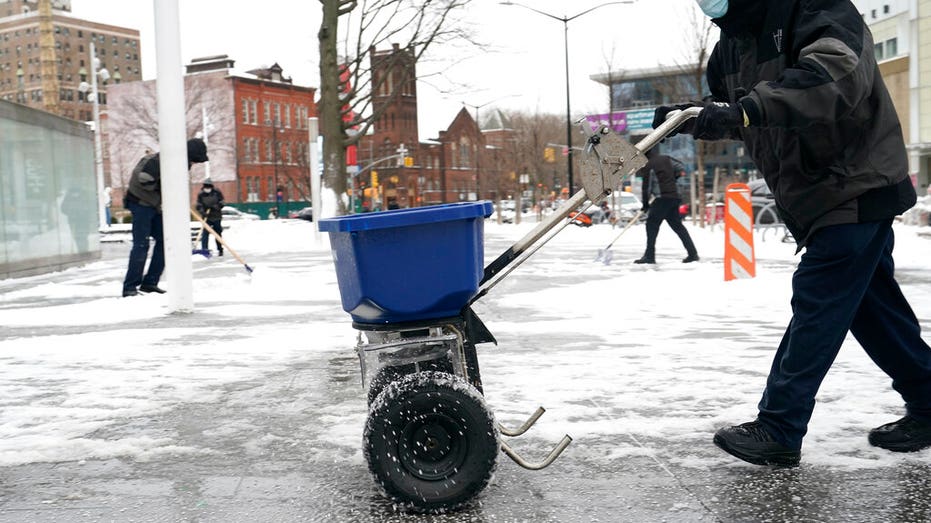Small business owners adapt to stay afloat amid pandemic
Medium Rare restaurant owner Mark Bucher and Little Believers Academy owner Cassandra Brooks share how they’ve adjusted to the new normal.
Nearly one year after the COVID-19 pandemic hit New York, parts of the Big Apple look more like ghost towns, lined with shuttered storefronts, empty office buildings and businesses teetering on the edge of closure.
Now industry leaders and struggling store owners are calling on the city and state to turn things around — before it’s too late.
“I’m not saying there will be an exodus in the city or the city is going to die” without help, said Gino Gigante, owner of the Lower East Side’s Waypoint Cafe — where sales tanked from $500,000 in 2019 to just $80,000 last year.
“But you’re going to see a lot of unhappy people and a lot of empty storefronts.”
Workers clear a sidewalk in front of a building in downtown Brooklyn after several inches of snow, sleet and freezing rain fell, Thursday, Feb. 18, 2021, in New York. (AP) As of this month, more than 47 percent of small businesses citywide remain closed, while revenue for those that are open has dropped nearly 60 percent, according to TrackTheRecovery.org, a Harvard University-run database tracing the virus’ economic impact. In Lower Manhattan, commercial office leasing dropped nearly 70 percent in 2020, while a staggering 12 percent of businesses — ranging from hotels to department stores to restaurants — closed for good, data from the Downtown Alliance shows. GET FOX BUSINESS ON THE GO BY CLICKING HERE “There are hours and hours where no one comes in the store at this point,” Alyssa Morrow, chief operating officer of SoHo clothing store The Vintage Twin, told The Post. “We’re down to bare bones.” Restaurants, bars and cafes have been among the businesses hardest hit by the pandemic. “We started out with 22 or 23 employees. Now we have about 10,” said Andrew Chase, owner of Cafe Katja on Orchard Street in Lower Manhattan. In a stark reminder of the dual dangers of the pandemic, those losses include a worker who succumbed to the virus at just 36 years old, Chase said. “It was just so tragic,” he said. “So all I care about is that everybody else is healthy.” Nevertheless, plummeting profits have sowed an uncertain future for Chase and his cafe, despite a GoFundMe cash drive, a loan through the federal Paycheck Protection Program and an understanding landlord taking their lease quarterly. Vacancy rates in residential, office and retail spaces have continued to skyrocket — with as much as 21 percent of buildings in parts of Manhattan and Brooklyn empty, according to data from Coldwell Banker Richard Ellis, the world’s largest real estate and investment firm. “New York City had a vacancy storefront crisis before the pandemic and it’s been exacerbated to levels unimaginable,” Andrew Rigie, the Director of the Hospitality Association, told The Post. A series of governmental failures only accelerated the process. It took 11 months to roll out an outdoor permit program for the city’s flailing live arts sectors, three of five promised emergency busways remain unbuilt, hampering transportation, and there’s still no aid package for tenants who collectively owe more than $1 billion in back rent. The Open Dining and Open Streets programs, which breathed a trace of life back into the city over the summer, only came after threats of legislation and pressure from lawmakers, while aid and loan programs for small businesses have totaled less than $100 million. New York must also address quality of life issues to convince tourists — and residents who fled — to come back, said Jerome Barth, president of the Fifth Avenue Association. NYC RESTAURANT OWNER FLEEING TO FLORIDA AMID COVID SAYS 'IT'S OPEN AND BUSINESSES ARE SURVIVING' “New York managed to become the number one tourism destination in the world by being the safest big city in the world and we need to own that label,” said Barth, referencing the homeless crisis, high murder rates and rising crime on the subways. “Perception is what matters in terms of people deciding whether or not to come to New York. While cracking down on quality of life issues, the city must be more forgiving when it comes to slapping businesses with penalties and fines for minor infractions, said Rigie, urging an emphasis on the things that make New York the greatest city in the world. “The city needs to embrace the energy that makes New York City so unique,” he said. “We need to continue with the outdoor dining, we need outdoor performances. “New York City needs to create reasons to bring people back.” Rigie and other industry leaders across the five boroughs said government red tape, coupled with complicated and inadequate relief efforts, is making it nearly impossible for businesses to bounce back. “It’s just so much simpler to operate in a lot of other places,” said Elizabeth Lusskin, the executive director of the Long Island City Business Improvement. “The rules are easier, the applications are easier, there’s a simpler bureaucracy around everything.” Those businesses not already forced to close may pack up voluntarily if the grass looks greener in other states, warned Lusskin. CLICK HERE TO READ MORE FROM FOX BUSINESS “If we want to keep a strong business climate here we have to up our game and really not take it for granted that everyone just wants to be here,” said Lusskin. “We are in a competition. And we’re New Yorkers, so we should win, but we’re not going to win just by default.” To read more from The New York Post, click here. Source: Read Full Article
